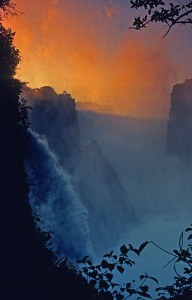
Victoria Falls at dawn — an unforgettable image. Photo by D.E. Cox, two-time Society of American Travel Writers photographer of the year.
In my travel writing for magazines, I confess I’ve sometimes felt like my words were there more to frame the pictures than to tell the story.
National Geographic Magazine, I’m told, always starts with a portfolio of superb photographs on a topic, and then builds a story around them, rather than have story ideas drive the decisions.
As I noted in a recent post, words — or content as they are now known on the Web — are crucial for conveying information and are the ultimate reason why most people go to a travel website.
But it’s the visual images — if done well — that become seared in our brains and very possibly lead us to choose one destination over another, even if only subconsciously. Visuals, in that sense, evoke primal emotions that words can’t always manage.
It’s one thing to write (to use a cliche) “spectacular snow-capped peaks” and another to view a photo of an Alaskan mountain range. With a photo, even someone from Fiji who has never seen snow can immediately envision what the words “spectacular snow-capped peaks” represent, and whether or not that’s something that he or she would want to see.
As a writer who also takes photographs — that is, the photography is secondary to my writing — I love and appreciate the power of the written word, but I also know that outstanding photography is crucial to putting together any kind of successful travel-oriented package.
To look at it another way, the travel business is the perfect vehicle for the use of images, because people tend to remember their prior travel experiences in visual terms. If they’ve been to Paris, their first association with the word might well be their first glimpse of the Eiffel Tower or Notre Dame. If they’ve been to Yellowstone National Park, they might first visualize Old Faithful erupting or a bubbling mudpot sending steam into the air.

Monticello, Thomas Jefferson”s home, is just outside Charlottesville and one of its prime attractions. Photo by Clark Norton
For a website’s home page, the more stunning the visuals, the better. I previously wrote about the extremely successful Facebook page that the Charlottesville ( Virginia) Albemarle Convention and Visitors Bureau has created, relying almost entirely on professional photographs of the city and its surroundings, augmented by just a few words. The photos evoke interest in visiting the area both from those who have never been there and those who have moved away but retain a real nostalgia for Charlottesville. Take a look at the page to see what recently made it the most popular Facebook city destination page in the U.S. The CACVB has also won awards for the visuals on its new website.
Studies have also shown that more people “like” Facebook posts when they’re accompanied by photographs, and more people click on google search results when an author’s face is pictured.
But this is also the age when everyone with a smart phone can take pictures — sometimes very good pictures — and when Instagram threatens to pass its owner, Facebook, in usage among young teens. (Baby boomers, it seems, are becoming the key Facebook demographic. But boomers like a good picture as much as anyone.)
And, as we’ve all learned of late (some to their regret), people love to share photos with friends, family, and for that matter, perfect strangers, as the popularity of Pinterest and Snapchat attest.
One good tactic for travel websites, then, is to encourage users to send in their photos of the regions, events or travel businesses they represent; staging contests — with the public voting on their favorites — is always a good choice. (Make sure you have permission to use and share the photos; make it a rule for entering the contest.) This type of interactivity helps gets users invested in the website and prompts them to return again and again.

Jester the Weimaraner puppy and Instagram marketer overlooks the Queensland coast. Photo from Brisbane Times
Queensland, Australia, among other destinations, has used resident photo-sharing — via Instagram — to good effect in its tourism campaigns.
Is a picture really worth a thousand words? As a writer, I hope not. (But maybe 500. )
This Week’s Travel Quiz:
In 2012, international tourists spent more money in the United States than oin any other country. Which country finished second?
A. Spain
B. France
C. Italy
D. China
I’ll have the answer in my next post.
Meanwhile, be sure to download my free report, “How to Ride the Coming Wave of Boomers,” available here. It’s all about the best ways to market travel to baby boomers — the biggest-spending group of travelers the world has ever seen. It’s also the easiest way to subscribe to my blog, so you won’t miss a posting. Thanks!












2 Responses to The Power of Images on Travel Websites